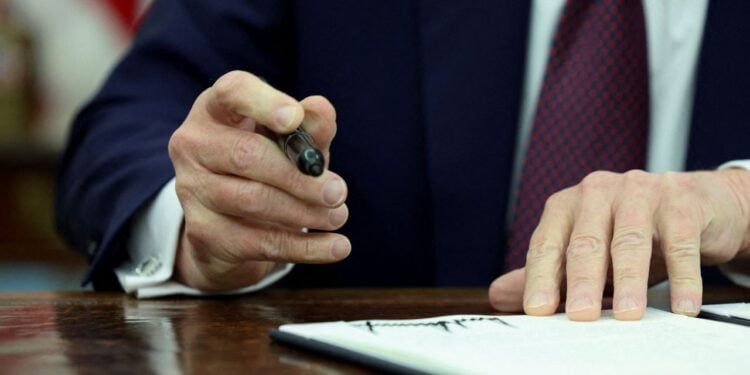U.S. President Donald Trump and his team have acted with stunning speed to begin removing or sidelining hundreds of government workers, while he has also sought to give himself the power to fire hundreds of thousands more.
The Republican president has been in office less than a week but the wrecking ball he has already taken to parts of the U.S. government has sent shock waves through much of America’s federal bureaucracy.
At the National Security Council 160 staffers have been sent home. About 20 senior career attorneys at the Justice Department were reassigned. The heads of the U.S. Coast Guard and Transportation Security Administration were fired along with other officials.
Government offices focused on workforce diversity are being permanently shuttered, the staff on leave, while a flurry of executive orders overturning Biden administration policy have left many officials uncertain about their futures, their mandate erased by a blunt stroke of Trump’s signature Sharpie marker.
Trump said on Tuesday he also plans to fire over 1,000 officials appointed by his Democratic predecessor Joe Biden.
The White House did not respond to a request for comment about government worker concerns.
During his presidential election campaign Trump frequently pledged to slash the size of government and rid it of bureaucrats deemed insufficiently loyal to his political agenda.
Still, the speed of Trump’s swift and coordinated moves targeting workers at a swath of government agencies shocked federal employees in Washington and even public sector unions who had spent months anticipating Trump’s arrival.
“A lot of people did not expect him to act with such a broad stroke,” said Don Quinn, an employment lawyer who represents federal employees. “And so there’s definitely a sense of disbelief. There’s fear — people are concerned about their livelihood, people are concerned about their families.”
Steve Lenkart, executive director of the National Federation of Federal Employees, faced a similar reaction when he addressed a group of 30 federal employees in a class he was teaching on Thursday.
“It was just stunned silence,” said Lenkart, whose union represents 110,000 workers. “Everyone is on pins and needles.”
Lenkart pointed to lesser-known agencies, like the TSA, where it usually takes months before a new administration gets around to replacing the leadership, that were targeted on Trump’s first full day in office on Tuesday.
Diversity Offices Closed
Coast Guard Commandant Admiral Linda Lee Fagan, the first female uniformed leader of an armed forces branch, was removed in part for what a Department of Homeland Security official said was her excessive focus on diversity, equity and inclusion policies.
In a memo released on Tuesday the Trump administration said that all federal DEI office staff would be placed on paid leave by 5 p.m. on Wednesday, because their offices were to close.
Federal agency heads have been asked to identify by Friday employees on probationary periods, or who have served less than two years. Such employees are easier to fire.
Trump also issued a freeze on federal hiring, except for military, immigration enforcement, national security and public safety jobs.
The 160 staff members at the National Security Council were told during a brief call on Wednesday to turn in their devices and badges and head home, a former NSC official said. They were people seconded to the agency from the State Department, the Pentagon and other parts of the U.S. government.
“It came as a surprise and a shock to people,” said another ex-official who spoke to former colleagues who were on the call.
Another former NSC staffer said that while it was not spelled out on the call, it was widely assumed the new administration believes the NSC harbors many it considers part of what Trump calls the “deep state” whose loyalty to him has been questionable.
Hundreds Of Thousands Could Be Fired
Trump signed an executive order this week that would make it easier to fire federal workers by reclassifying their job status — an order that concerns these employees the most.
The National Treasury Employees Union, which represents 150,000 employees in 37 federal agencies and departments, sued Trump and other administration officials on Monday in federal district court for the District of Columbia, seeking to block the order.
The union argues in the lawsuit that the order wrongly applies employment rules for political appointees to career staff.
The vast majority of the more than 2.2 million employees of the federal government are career civil servants who are hired on merit and serve the government as a whole. Civil service positions do not terminate at the end of an administration and civil servants can only be fired for cause.
Trump’s order creates a new, much larger category of federal employees called “Schedule Policy/Career” who would not have the typical protections enjoyed by civil servants and can be fired at will.
By deeming anyone involved in “policy” as part of this new category, the pool of people that could potentially be fired expands enormously, because nearly everyone in government touches policy in one way or another, said Don Moynihan, a professor at the Ford School of Public Policy at the University of Michigan.
Trump ordered the reclassification of many government workers at the end of his first term, known as Schedule F, which Biden rescinded on his first day in office in 2021. Estimates then were that Schedule F could make at least 50,000 federal workers vulnerable to being fired.
The new order is broad enough that hundreds of thousands of people could be reclassified, Moynihan said, before firings begin.
Everett Kelley, national president of the American Federation of Government Employees — the largest federal employee union representing 800,000 federal and D.C. government workers — said members are worried.
“The members I’ve heard from are anxious and uncertain about what the future holds for their employment and for their families,” Kelley said.
(Reporting by Tim Reid in Washington. Additional reporting by Andrea Shalal, Nathan Layne and Matt Spetalnick; Editing by Ross Colvin and Howard Goller)


 Dr. Gleb Tsipursky – The Office Whisperer
Dr. Gleb Tsipursky – The Office Whisperer Nirit Cohen – WorkFutures
Nirit Cohen – WorkFutures Angela Howard – Culture Expert
Angela Howard – Culture Expert Drew Jones – Design & Innovation
Drew Jones – Design & Innovation Jonathan Price – CRE & Flex Expert
Jonathan Price – CRE & Flex Expert















